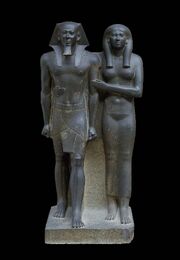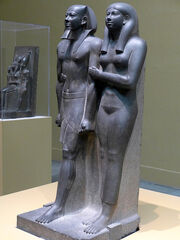
Photo of the sculpture of Menkaura and his wife

Photo of the sculpture of King Menkaura and his wife (Right Angle)
Brief Identification[]
This sculpture of King Menkaura and his wife, which is about 2/3 life size, was created between 2490 BCE and 2472 BCE. It was produced during the 4th dynasty of Old Kingdom Egypt during the reign of King Mycerinus for the purpose of housing the souls of both the king and his wife after their deaths. Once their real bodies deteriorate the souls were believed to transfer to the statues. The sculpture was found in a tomb in Giza, Egypt and was then transferred with permission of the Egyptian government to The Museum of Fine Arts Boston.
Technical Evaluation[]
The sculpture was blocked out in the general shape of the figure with the help of red guiding lines [See Smith 1960, 43]. The statue was then further shaped and polished. A combination of copper and stone tools were used in the construction process. Stone abrasion tools, a copper saw, and copper drills were used f shaping. Polishing was accomplished with rubbing stones. The makers likely used a quartz grinding paste in order to make the copper tools effective [See Smith 1960, 43].
The sculpture was constructed out of greywacke, a form of quickly deposited sandstone. The sculpture was not completed carved, likely due to the death of the king. Although the carving process was not completed, the sculpture was still painted with red and black paint [See Aldred 1965, 31]. The copper and greywacke were likely sourced semi-locally from the Eastern Desert and Sinai Peninsula.
The sculptors who created the artifact used did not focus on intense detail. There are few plastic features on this sculpture like The Reserve Heads [See Smith 1960, 43].
The artifact was excavated by the Harvard University-Museum of Fine Arts Expedition in 1909. It was then placed in the care of The Museum of Fine Arts Boston by the Egyptian government in 1911.
Local Historical Context[]
The culture that created this sculpture had a long history of massive pyramids and extensive art which showed the power of the rulers. Massive architectural projects cemented their high status in the universe. Egyptian society held the belief in a life after death. Massive tombs were constructed by the rulers to provide a secure location for their bodies after death. Many luxurious items would be placed in the tomb including furniture, food and art. This would ensure a comfortable after life.
The 4th dynasty (2613-2494 BCE), during which this sculpture was created, was marked by the construction of grand pyramids. Mycerinus, following his precursors, also constructed pyramids but at a slightly smaller scale. His tomb, the Pyramid of Menkaure inmmmm Giza, was the home of the sculpture of the king and his wife until its discovery.
Little detail has survived about the historic events during the 4th Dynasty in Old Kingdom Egypt. There were small expeditions into the surrounding areas. Sneferu, the founder of the 4th dynasty, led expeditions into Sinai against local chiefs. These were likely to maintain mining operations. According to Sneferu’s Annals on the Palermo Stone, Sneferu also raided the Nubians. This raid by Sneferu ensured control of quarries that supplied many construction projects in Egypt. By the time of Menkaura, Nubia was well under Egyptian control [See Smith 1960, 25].
The statues that were placed into these tombs served the purpose of a permanent replacement of a body after death. These statues also symbolized a changing relationship between man and wife. It showed the husband standing strong with the wife embracing him. The symbolism was not intended by the creators but gives historians an idea of the ideals of Egyptians at the time. These statues were not created to be viewed and appreciated but rather to be hidden away with a practical purpose [See Aldred 1965, 2]. The sculpture was likely created by a team commissioned by the king himself [See Hawass 1987, 525].
World Historical Significance[]
The artifact reinforced the importance of the after life for ancient Egyptians. This would remain a core pillar in their religion for centuries. It reflected a clear picture of the current religious beliefs at the time of its creation [See Aldred 1965, 6].
The statue and the other statues discovered in the pyramid complex of Menkaura are important to the overall history of Egypt. Statues like the statue of Menkaura and his wife were not found in the other complexes of kings in Old Kingdom Egypt, such as Khufu. Most of 4th dynasty Egypt’s statues that survived to today were found in Menkaura’ s tomb.
This statue and surrounding artifact’s in Menkaura’ s tomb reveal a shift away from his predecessor’s gods. Menkaura decided to return to worshipping Ra.The structure of this court and the placement of certain statues conveys this. The pyramids and sculptures within, effective show the shifts in religion. [See Hawass 1987, 532].
The statue is unique in that it has emotion than traditional statues of the period. The statue exemplifies divine majesty but the wife’s arm around the king in this statue is a new feature. This was one of the first examples of a wife supporting a husband and being on semi-equal footing in Egyptian culture. Many future dynasties would feature this in their sculptures. [See Aldred 1965, 31]
Bibliography[]
Aldred, Cyril. The Development of Ancient Egyptian Art From 3200 to 1315 B.C. London: Alec Tiranti, 1965.
Smith, William Stevenson. Ancient Egypt as Represented in the Museum of Fine Arts, Boston. Boston: Museum of Fine Arts, 1960.
Aldred, Cyril. Egyptian Art in the Days of the Pharaohs, 3100-320 BC. London: Thames and Hudson, 1980.
Ladouceur, David J. “Old Kingdom Period in Egypt.” Hackensack Salem Press Encyclopedia, 2013.
Hawass, Zahi A., The Funerary Establishments of Khufu, Khafra and Menkaura During the Old Kingdom. Ann Arbor: University Microfilms International, 1987.
https://library.artstor.org/asset/AMBOSTONIG_10313608722.
https://www.mfa.org/collections/object/king-menkaura-mycerinus-and-queen-230
https://www.nps.gov/goga/learn/education/graywacke-sandstone-faq.htm